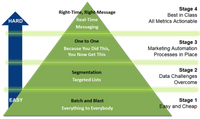A best-in-class market segmentation will always be a dynamic and
multi-purpose one so that all stakeholders can benefit
Market Segmentation
Admittedly, the science of economics has become tired of exploring and suggesting more and more ways of segmenting a market. Master theses and PHD-projects heading for market segmentation are hardly admitted by universities any more. Still, most companies feel they better don’t go without.
Segmentation does not only support sales guidance or segment-specific market communication, differentiated sales stories and value propositions, but above all defining, for each segment, the most promising position as opposed to our competitors. On this level, it delivers the most valuable framework product management can refer to.
A market segmentation, done from the scratch, requires a huge quantitative effort with questionnaires that easily feel like grilling to the interviewee. This is nothing to be repeated each time the head of marketing is exchanged.
This is one of the major reasons why we recommend a) to use as much existing input as possible prior to talking to the market and b) to go for a dynamic segmentation that serves multiple goals such as product positioning, market communication or sales guidance.
A segmentation is not to be mixed up with a categorization as frequently available in customer databases. A healthcare provider, for instance, may serve hospitals, private practices and outpatient centers, among the hospitals small, medium, large ones, university clinics and private chains. He may enjoy a low, medium or deep penetration level and rather compete against competitor A, B or C. Doing business with these customers can be “challenging”, “normal” or “easy”. All this is valuable insight yet not a segmentation.
Among the most valuable types of segmentation are those that are called “needs-based”. They show how individual groups of customers (or potential customers) differ from each other in terms of typical needs. Turning back to the healthcare example, they may have basic clinical needs, advanced or even expert-level, scientific clinical needs. On a business-level, they may strive for mere survival, for routine business, for competitiveness or even for leadership in their category. All these segments will show different needs in terms of products and services. Packaging our offerings and profiling ourselves in strict accordance with the segment-specific needs (as opposed to knocking all doors with our full portfolio) will give us strong competitive advantages, a more specialized reputation and a jump in sales efficiency.

